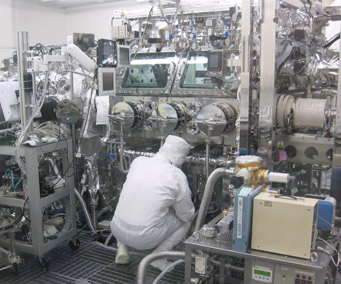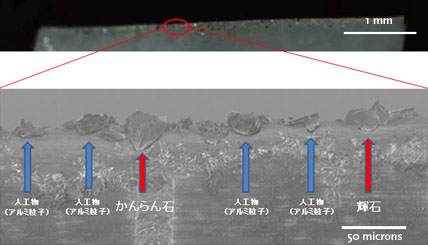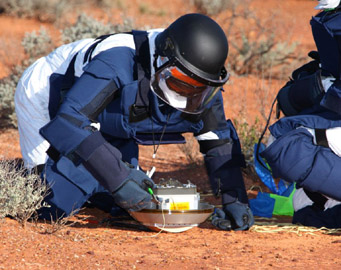According to the Meteoritical Society's master database, to date researchers have identified 39,579 confirmed meteorites.

The small container returned by Hayabusa is being analyzed and opened inside this maze of stainless-steel plumbing in a clean room at the Sagamihara campus of the Japan Aerospace Exploration Agency.
Michael Zolensky
Now you can raise the total to 39,580, with the announcement by the Japan Aerospace Exploration Agency that particles found inside the sample capsule from the Hayabusa spacecraft are indeed tiny bits of asteroid 25143 Itokawa.
As you'll recall, the capsule returned to Earth on June 13th in a spectacular nighttime reentry over south-central Australia. Recovery crews scooped up the capsule the next day. In the months since, meteorite experts have been hunkered down in a special clean room at JAXA's Sagamihara campus, meticulously examining the capsule's interior.
Prospects brightened in July when the team found small bits inside the container. But it's taken until now to confirm that the particles are truly extraterrestrial — "mostly iron-rich olivine and pyroxene particles," reports investigator Sho Sasaki (National Astronomical Observatory of Japan). They are "compatible with LL composition," Sasaki notes, which means they contain little iron or nickel.
That's consistent with the composition of tiny Itokawa derived from Hayabusa's instruments and from Earth-based observations, which suggest that this small elongated body — only 2,100 feet (630 m) long — is an S-type asteroid with a rocky composition.

Tiny particles line the edge of a special spatula used to extract them from Hayabusa's sample container. Shown magnified in the lower panel, most of the particles (blue arrows) are microscopic shards of aluminum from the container. The ones with red arrows consist of olivine (left) and pyroxene (right).
JAXA
According to a JAXA press release, microscopic particles were collected using a special Teflon-coated spatula. Thousands of particles, most no bigger than 10 microns across, apparently hitchhiked home from Itokawa.
Some of these are aluminum flakes created by opening the enclosure — but most are not. "The minerals are all extremely rare and never found together on Earth," explains Michael Zolensky, a NASA scientist who helped with the analysis. "But they constitute the major minerals found in some ordinary chondrite meteorites."
All of the tiny bits removed so far are from sample catcher A, and Zolensky believes many more remain inside it. Sample catcher B, not yet been opened, might also contain asteroidal samples.
This must be an especially satisfying outcome for the small team of engineers who coaxed Hayabusa back to Earth in the face of tremendous technical obstacles.

Japanese technicians inspect the Hayabusa sample capsule the day after it landed in Australia on June 13, 2010.
JAXA
Launched in May 2003, the craft was damaged by solar flares even before reaching its destination. It arrived safely but then failed to drop an instrumented probe called Minerva onto Itokawa's surface. A combination of communication blackouts and technical glitches befell Hayabusa when it attempted to land and collect samples in November 2005, leaving scientists back on Earth fearing that the craft would return to Earth empty-handed.
Then things got worse. The craft suffered ruptured lines, spewing corrosive fuel throughout its interior. It lost its batteries and attitude-control thrusters. No longer able to point Sunward, Hayabusa basically froze up. Engineers eventually regained control, but not until 2006, after the craft looped somewhat closer to the Sun, did everything warm to the point that a gradual recovery could begin. Always seemingly one more malfunction away from complete failure, Hayabusa (meaning "falcon") limped home.
For more than seven years, officials at the Japan Aerospace Exploration Agency have been keeping their eyes on a "success scorecard" for Hayabusa, the nation's first mission to an asteroid. Just like the warm-up questions on Who Wants to Be A Millionaire?, the first few tasks were relatively easy:
- Operate ion engines (50 points)
- Operate ion engines for more than 1,000 hours (100 points)
- Rendezvous with Itokawa (200 points)
It's taken a lot longer than expected, but at long last the Hayabusa team can check off the mission's final and most difficult objective:
- Sample obtained for analysis (500 points)
 1
1
Comments
Bruce
November 18, 2010 at 2:52 pm
The major scientific goal of sending this robot on a 7 year, multimillion dollar round trip was to bring back a sample of Itokawa. Personally, if I were handing out points, I would be embarrassed to claim 500 points for returning those samples. Having the sampling mechanism get so complex that it essentially failed is a classic piece of engineering hubris right up there with the defective Hubble mirror.
You must be logged in to post a comment.
You must be logged in to post a comment.